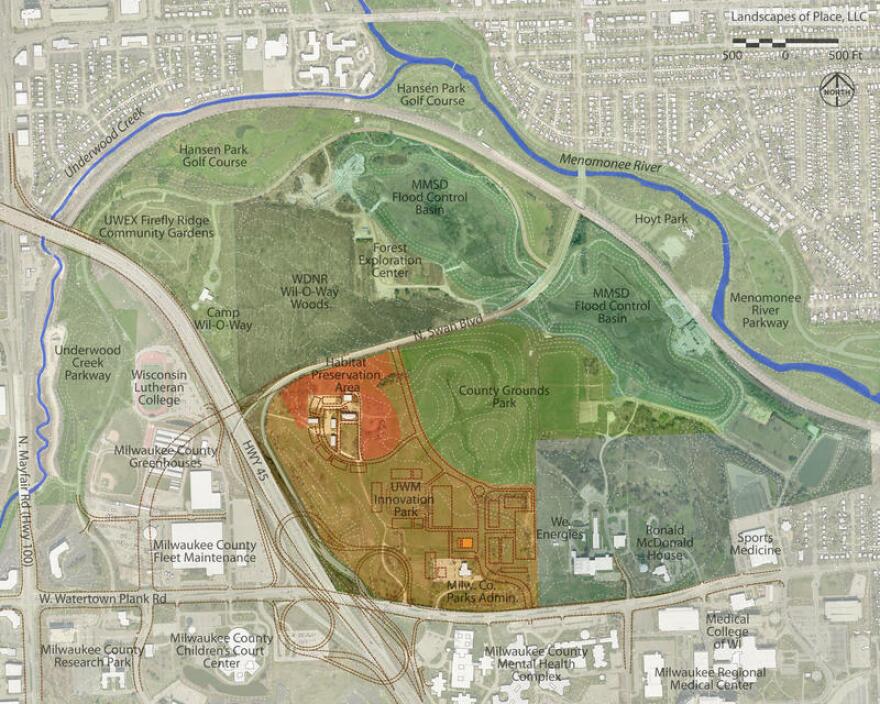Wauwatosa is re-envisioning the city's southwest corner, in its Life Sciences District Plan. The area includes the sprawling medical complex, including Children’s and Froedtert Hospitals, and what, for years, was known as the Milwaukee County Grounds.
Some people are zeroing-in on a small, wooded piece within those grounds and are expected to flock to an open house meeting on February 7 from 5:30-7:30 pm at Wauwatosa City Hall.

“What saddens me is that people are focusing in one area and making a lot assumptions that elected officials are doing this for greed or they’re going to be paid off by developers. That’s not what’s going on here, that’s not at all what’s going on here,” Wauwatosa Mayor Kathy Ehley says.
Ehley emphasizes no decisions have been made. “This is much more complex than one little portion of a 1,200-acre span that we’re doing concepts for right now. And that’s what I have to stress right now – the consultant came up with some concepts and now we have the opportunity to say ‘like this, don’t like this’,” she says.
The mayor says Wauwatosa must find ways to maintain its infrastructure and pay for community services.
“Right now, Wauwatosa is dealing with the fact that 38 percent of our landmass is nontaxable, that’s high. So the remaining land that we do have, we have to make sure we’re growing, evolving and maximizing that land value,” Ehley says.
So what about the future of the 22-acre wooded pocket that supporters call Sanctuary Woods?
First of all, Ehley says, “That’s not an official term!” And she adds, she happens to enjoy hiking the woods too.
“It has the opportunity for a lot more people to be enjoying, if we can do some planning,” Ehley says.

Gary Casper has information he thinks could help the community make a good decision.
Casper is the field biologist who’s been studying the so-called Sanctuary Woods as a part of a bigger project the EPA asked him to undertake.
“The objective here is to try to get a better understanding of wildlife species in the northern half of Milwaukee County, as the EPA would put it ‘what has been impaired’,” he says.
For the last three years, Casper and fellow biologists have fanned across the woods and nearby undeveloped spaces.
“One of the most exciting things about our study is that we were finding all sorts of things we never expected to, somehow hanging on…last year we finally found tree frogs,” Casper says.
While walking with through the woods, Casper looks for long-eared owls. “So we’re entering the aspen grove. Look at the size of these things! They provide the habitat for the owls, flying squirrels,” he says.
You heard right -- flying squirrels.
One development idea suggests that Wauwatosa approve multilevel apartments near the woods' edge.
“The late afternoon sun we see right now would be wiped out. Wildlife is also impacted by noise and artificial light,” Casper says.
Another proposal would create a scenic drive that would cut through the parcel.
“Roads impact wildlife in many ways. One is just loss of habitat from paving it over. Then comes other incidental impacts – traffic on a road that can directly kill and usually with a road comes development, so there’s a lot more intensive use of the area – more disturbance, more noise, more pollution,” Casper says.

The biologist says the natural area comes with benefits beyond the wildlife it sustains. The Menomonee River, at its nearest point is 800 feet from the woods.
“Part of the problems with our water quality, a big part of the problem is that fact that we’ve lost our shoreline habitats. Those are the sponges that filter the water and keep it clean. A trout is not going to do very well unless there are a lot of insects to eat. While the insects need the shoreline habitat. So it’s all connected,” Casper says.
He and his colleagues will share everything they’ve learned about the sanctuary with Mayor Ehley.
Then Casper will pull on his boots and head out to collect more data, while city leaders examine all the facts.






